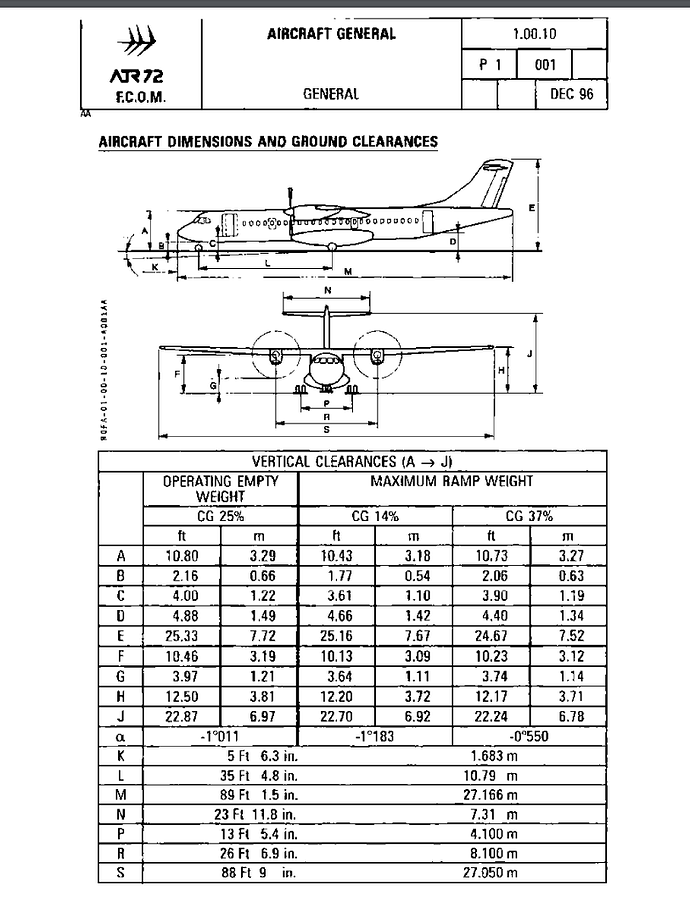I tried:
With that weight above, to keep climbing to 24,000ft, i must put throttle lever at MAX (not Notch) & power management to MCT (not CLB) to keep my airspeed not go down to stall.
^ is this normal or i’m missing something?
And how do you determine your cruise altitude based on weight?
1 Like
When you’re fully loaded, you might not reach 24,000 ft easily in the ATR 72. It’s normal to need more power, but max throttle sounds a bit high.
To find the best cruise altitude based on weight, check the ATR 72’s flight manual. Generally, if you’re heavy, cruise at lower altitudes. As you burn fuel and get lighter, you can go higher.
Make sure your gear and flaps are up, and you’re not climbing too fast
Just use simbrief, and import FP to FMS.
2 Likes
They don’t typically go over 18,000. I usually cruise at 6,000 on short hops, 12-16 on medium to longer routes… and 18,000 over terrain.
I see, i don’t understand how to read your attached picture. But do you know what cruise altitude do real life ATR 72 usually cruising?
^ if this is true based on real life ATR 72, then this information is helpful for my basic info.
17,000 to 25,000 feet being max. it depends on the terrain, weather etc
Flightplan. Simbrief will let you know your cruise alt. Although you have to enter weighs and cruise alt manually into FMC. Still, it gives you your target ceiling for the flight. I rarely get sent above FL190, Occasionally FL210, never higher. Often lower for shorter hops.
Did a heavily loaded (passenger & cargo) flight from EGGD to EIDW earlier and cruise was at FL140.
1 Like
I see, i sett route in mcdu and the cruise altitude from the mcdu is written as 24,000ft. But i’m struggling to climb, have to max throttle lever & power management to MCT (this make the engine temperature going red, after several minutes the engine auto down to make the temperature green again, then auto engine up again until the temperature going red again)
^ this make me strugle to reach 24,000ft
The ATR should be climbing in VNAV IAS mode with the speed limit set to auto 170kts, and power dial set to CLB and throttle in NOTCH. It doesn’t climb fast though, it’s not a A320!
Simbrief is an app downloaded from fbw downloader?
And what is FMC?
I sett route in mcdu and full loaded weight, but the highest alt written in mcdu route is 24,000ft
I already did this, but seems 24,000ft for ATR is overkill, the ATR strugle to reach that alt
Simbrief is a web based flight planner now owner by Navigraph. Very good though.
I have not tried to reach the service ceiling, which may be payload dependent. Max I’ve seen from simbrief is FL210.
Alright, will try this tomorrow.
First of all 100% weight is a flight sim thing. All above when it comes to payload. You can put 100 tons of payload in any aircraft, as long as it’s sturcture can carry it. Can you fly with it? Sure, if your fuselage can take the speed it requires to build enough lift.. You ge tit, it’s not that easy, there come things into play.
Most importantly, every airplane has a max takeoff weight, short MTOW. You can take the MTOW of your airplane from the fuel and payload window in the sim.
Then you need a certain amount of fuel. Fuel burn is dependant on the weight of your plane but to keep it a bit simpler, let’s assume you need a certain amount of fuel to get to your destination. When you have added this fuel your plane’s actual weight will be higher than before, obviously. The difference between this current weight and the MTOW is the amount of payload you can take with you.
Usually this is done the other way round, you’ve got your passengers or cargo and this loaded you’ll get your Zero Fuel Weight, ZFW. Now you can top up your tanks until you reach MTOW.
Then. This MTOW is the limit the airplane is certified to fly with. Many factors are taken into account to determine the MTOW, it’s not the structural limit. But if you start your flight at MTOW you will likely not be able to reach the certified cruise ceiling of an aircraft. I assume that the 24000 ft of the ATR come from its pressure body, its pressurized cabin, but I don’t know that detail. The DC-6 for example could easily climb up into the 30’s but its pressurized cabin is limited to 25000’.
When fully loaded you might not even get close to the certified ceiling. More weight requires more lift and lift comes from the airfoil of the wings and the angle of attack, the angle between the wings and the vertical direction of flight. The higher the angle of attack the higher your drag. The more drag the more power is needed. No power left, no further climb.
As long as you learn an aircraft and generally the (physical) rules of aviation I’d recommend you keep the weight down a bit. Once you get the hang of it be prepared that higher weight will (!) change the flight characteristics of your airplane.
2 Likes
I usually calculate the cruising altitude based on a estimated flight time. Generally you want to be at cruising alt for minimum 10 minutes. If you give the ATR roughly a minute to climb or descend 1000 feet, you can calculate for example a 22min flight at FL060… 30min flight at FL100… and anything over 45min capped at FL180.
I participated in ferry flights , full fuel at T/O , 4 pilots 1 mech on board , some freight , at 23000 fts each leg.
